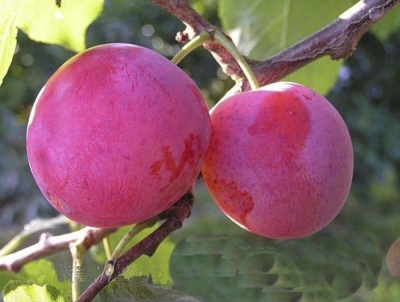
- Authors: V.A. Matveev, Z.A. Kozlovskaya
- Appeared when crossing: Eurasia 21 x Hungarian Azhanskaya
- Growth type: vigorous
- Crown: round, spreading
- Fruit size: very large
- Fruit weight, g: more than 40
- Fruit shape: rounded
- Fruit color: the main color is light green-yellow, the integumentary color is expressed by a bright red blush over the entire surface of the fruit
- Pulp (consistency): juicy, medium-dense
- Pulp color : yellow
Plum variety Delicate is intended for fresh consumption. It is considered to be quite fruitful. Plum Delicate was obtained by crossing the varieties Hungarian Azhanskaya and Eurasia 21.
Description of the variety
This variety belongs to the vigorous species. His crown is spreading and round. Plum Delicate is partially self-fertile. She will need pollination with other types of home plums.
Fruit characteristics
The fruits are very large in size, the weight of one berry is more than 40 grams. Their shape is round. The color of ripe fruits is light green-yellow; a bright red blush can be seen on the surface.
The pulp of ripe berries has an average density, it is very juicy, its color is yellow. The bones are rather small inside, the separation of the bone from the pulp is good.
Taste qualities
Plum has a delicate sweet and sour taste. The tasting score is 4.3 points.
Ripening and fruiting
This variety begins to bear fruit 3-4 years after planting in the ground. The variety is considered early. The fruiting period is in August.

Yield
Plum Delicate is considered fruitful. Up to 20 centners of ripe fruits can be harvested from one hectare of land.
Growing and care
Plum planting can be done both in spring and autumn. The first option is considered the most preferable. This variety is best planted on fertile soils: black soil, loam, sandy loam and chestnut soil.
You should not plant a crop in places where groundwater passes. It is also not recommended to plant near large trees, which can create shade and take water from other plants.
About a couple of weeks before planting, holes are dug. Their depth should be about 60-70 cm. Humus and superphosphate are added to the dug holes.
If the soil is too acidic, then ash or dolomite flour is also added there. After that, drainage is poured at the bottom of each pit. Then the holes are half filled with earth. Next, the young plum saplings are carefully lowered into the pits. The root collar will need to be placed 3-4 centimeters above the soil surface.
When planting, the roots of the plant are carefully but carefully straightened. They are sprinkled with earth a little. All this is slightly compacted. After that, the seedlings are well watered. One young plant has 3-4 full buckets of water. When all the moisture is absorbed into the soil, it is mulched with humus or peat.
It is better to fix a peg together with each seedling. The stem of the plant is tied to it with a soft rope. The distance between vegetation and support should be approximately 10-15 centimeters.
In the process of its growth and development, the plum will need watering.Remember that the ground should always be slightly damp at a depth of at least 40 cm. During periods of drought, there will be at least 5 buckets of water per tree.
And also the plum will need additional feeding. Mineral fertilizers are applied annually. During the growing season of vegetation, compositions with a high content of nitrogen, magnesium and potassium, phosphorus are required. In the spring, a solution of urea and potassium sulfate can be added under the drain
During the formation of fruits, the soil around the trees is abundantly watered with a solution of chicken droppings (in a ratio of 1: 20). In the autumn season, it is recommended to carry out foliar feeding with potassium sulfate, as well as superphosphate.
If you plan to use various liquid nutrients for fertilization, then you should remember that they are applied only to pre-dug holes. Moreover, they should be dug at a distance of 70-80 centimeters from the trunk.
It is important to remove overgrowth in a timely manner. Otherwise, the yield of fruit trees will be significantly reduced. The shoots are either dug up or cut with a garden shears. This procedure is performed several times during the summer season.
In addition, this crop also needs proper pruning. Formative pruning is performed in the spring of the following year after planting in the ground. In the first years, too thickened crown is often thinned out, the growths are shortened.
To protect the crop from diseases and pests, in early spring and autumn, it is recommended to spray the crown of trees and the ground in the near-stem zone with Bordeaux liquid (3%). It is best to use a spray bottle for this treatment.





Despite the fact that plum is considered more hardy than many fruit trees, it is not immune from diseases. It is attacked by viral, fungal and bacterial infections, and parasitic insects harm it. It is necessary to notice and recognize the signs of plum disease in time. They are easier to deal with and defeat early on. Well, in order to protect the garden tree from such a misfortune in the future, preventive procedures can be carried out.



































































